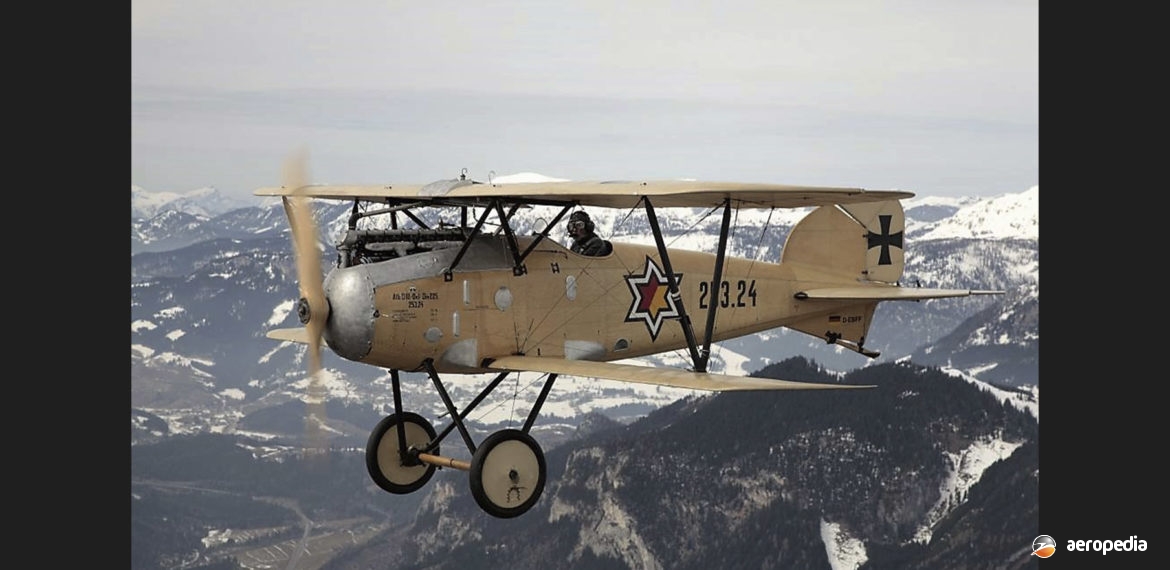Photograph:
Albatros D.III reproduction 253-2411 / D-EBFF flying in Austria in 2012 (TVAL)
Country of origin:
Germany
Description:
Single-seat fighter scout
Power Plant:
One 131 kw (175 hp) Mercedes D.IIIa six-cylinder in-line liquid-cooled engine
Specifications:
- Wingspan [upper]: 9.05 m (29 ft 8¼ in)
- Wingspan [lower]: 8.74 m (28 ft 7 in)
- Length: 7.33 m (24 ft 0⅝ in)
- Height: 2.98 m (9 ft 9¼ in)
- Wing area: 20.5 m² (221 sq ft)
- Max speed at 1,000 m (3,280 ft): 165 km/h (108 mph)
- Max speed at 1,981 m (6,500 ft): 156 km/h (97 mph)
- Max speed at 3,993 m (13,100 ft): 150 km/h (93 mph)
- Initial rate of climb: 1,000 m/min (3,280 ft/min)
- Time to 2,987 m (9,800 ft): 12 mins 1 sec
- Time to 4,999 m (16,400 ft): 24 mins 48 sec
- Service ceiling: 5,486 m (18,000 ft)
- Endurance: 2 hours
- Fuel capacity: 109 litres (24 Imp gals)
- Empty weight: 661 kg (1,454 lb)
- Loaded weight: 886 kg (1,949 lb)
>
Armament:
Two 7.69 mm (0.303 in) fixed forward firing Spandau machine guns synchronised to fire through the propeller
History:
The Albatros D.III was designed by Robert Thelen as a successor to the D.1 and D.II series. It adopted some of the advantages of the design of the Allied Nieuport Scout then in service, performance being increased by the installation of an uprated Mercedes D.III engine, this being achieved by increasing the compression ratio. The design was changed to increase pilot visibility, including revision of the layout of the wing, changing to a sesquiplane configuration, the upper wing having increased span and the radiator being re-located to the starboard side of the centre-section.
The wing structure was all-wood, with two box-spars located forward, with the front spar connected to the leading-edge with a ply capping strip. The ailerons were steel tube framed of different design and the aircraft had flattened fuselage sides. Once in service it became known to RFC pilots as the “vee strutter” and it was popular once it entered service early in 1917. Its main victim was the RAF BE.2c operated in the armed reconnaissance role over the front, it being an easy victim because of its slowness and poor armament.
The D.III was flown by 37 Jagdstaffeln and one painted scarlett (789/17) was flown regularly by Baron Manfred von Richthofen, he having shot down Harry Hawker in November 1916. However, once the Sopwith Triplane and Spad S.VII, and later the RAF SE.5 and Sopwith Camel, entered Allied service, the superiority of the D.III disappeared. Built in large numbers, the D.III was soon replaced in service by the D.V series.
A large number of captured aircraft [as many as 70] were placed in storage at No 2 Aircraft Salvage Depot in the United Kingdom for eventual shipment to Australia as War Trophies for placement in a museum. It would appear that at least part of one Albatros D.III reached Australia. This aircraft, serial D636/17, was shot down on 8 October 2017 when flown by Oberleutnant Gustav A Dittmar of Flieger Abteilung 300 which was operating from Samach airfield. Whilst flying with another aircraft from No 111 Squadron flown by 2nd Lt R C Steele, a Canadian, and Lt J J Lloyd-Williams based at Deir el Belah, flying in Royal Aircraft Factory FE.2b (serial A7194), contact was made with the two D.IIIs and following bullets passing through Dittmar’s fuel tank and radiator he glided to a landing between Goz el Basal and Karm in Palestine.
The aircraft and pilot were captured by troops of the Australian 9th Light Horse. The aircraft was towed to Deir el Belah airstrip and then moved to the airfield from which No 1 Squadron AFC operated at Weli Sheikh Nuran. The aircraft was repaired and is believed to have been test flown. It was inspected by General Allenby and had RAF roundels painted on the fuselage. In 1918 it was gifted to the Khedive (King) of Egypt and taken to Cairo. Its ultimate fate is not known but it is assumed it was broken up. Eventually in 1990 the wing fabric was donated to the Aviation History Museum of Western Australia by the family of Lieutenant F C Conrick formerly of No 1 Squadron AFC.
In later years replicas or reproductions of World War I aircraft have been popular and examples of the D.III have been constructed. One has been flown in Germany as D-EBKF and painted as 253/2411.

